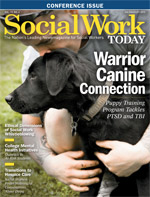|
Best Friends In 1870, a Missouri farmer shot a neighbor’s dog and during the court case in which the dog’s owner sued for damages, the lawyer gave an emotional speech from which the phrase “a dog is a man’s best friend” may have originated. Other accounts refute the story but whatever the origin, dog lovers know intuitively why the adage rings true, and I count myself among those smitten by the camaraderie of our loyal furry friends. For others like me, our cover story will be preaching to the choir about the multiple benefits of the Warrior Canine Connection’s (WCC) the animal-assisted therapy. So perhaps this story will better inform those unconvinced of how this program has changed the lives of more than 100 service members whose symptoms of PTSD and mild traumatic brain injury (TBI) have been remediated after not responding to traditional treatments. One of the best ways to characterize this program’s benefits is through the ‘dog as best friend’ comparison. While not everyone has or loves dogs, most of us have best friends. Each of us knows why those individuals are our closest friends: They are the ones who remind us to stop living in the past and “stay in the moment” when we are depressed or regretful. They’re the ones who make the extra effort to get us out of the house when we are isolating, distraught, or anxious about a personal or family crisis. They’re also the ones who demand genuine emotional investment in the relationship and don’t settle for superficial platitudes or phoniness. The WCC program’s dogs make many of the same connections with their service members/trainers as our best friends do with us. They have helped service members stay in the “here and now” during stressful events in training and address core symptoms of PTSD and mild TBIs, including reexperiencing, avoidance, and arousal. Dog training requires a close bond between a trainer and dog, making emotional numbness impossible. Training also requires frequent interactions in the community, decreasing the tendency to self-isolate and avoid socialization. These are just a few of the parallels that mirror the bonds of best friendship that have made the WCC program so effective when other treatments have failed. Read our cover story for more about the scientific and theoretical underpinnings that support animal- assisted therapy, and the success of the WCC program that will hopefully will put it on the fast track for designation by the military as an evidence-based intervention. We welcome your feedback at SWTeditor@gvpub.com. |

 July/August 2013 Issue
July/August 2013 Issue